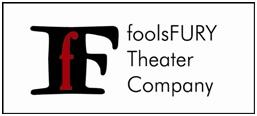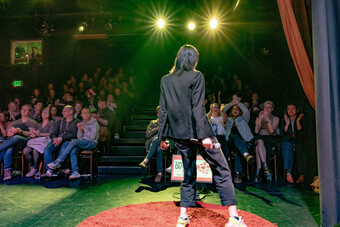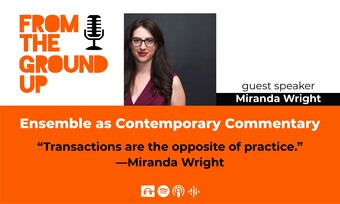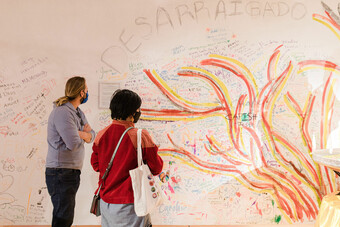Ensembles
Exploring foolsFury
Creating ensemble-based theater is one thing. Paying for it is another. Jeffrey Mosser does three case studies of established ensemble theaters exploring the creating and paying for the art.
foolsFURY is a theater ensemble from San Francisco that sees advantages in working with playwrights and devisors, and seizes opportunities to become a touring company. As they come up on their fifteenth year, artistic director Ben Yalom sheds some light on their transitions, and lets me in on how they are working toward what is next artistically and financially.
“The ensemble aspect formed three years into the company—around 2000. I sat down and figured out ‘what do we want to do with this?’ So we gave it a structure and decided who we wanted to work with and what we loved,” says Ben Yalom, Executive Aristic Director of foolsFURY in San Francisco. According to Yalom, until that point they had done mostly what he wanted to do, but the conversation then became broader.
At the time there were three members: Yalom as Artistic Director, Jennifer Caleshu with an interest in producing, and Stephen Jacob who was principally an actor, though also providing administrative support. For the next few years they worked with up to five staff members who ranged from quarter to full time, and, after a couple years, all of whom got paid. “It’s never been much, but there’s something about people making it official with the company,” says Yalom. Now, fifteen years later, they are a three person core staff (depending on production schedule) with twelve associate artists. Staff members make from $12-1500/month for about half-time work. Artists on a particular project make $100-$200 per week—depending on travel for the company. “We have certain expectations of company members: [attend] group trainings, meetings, and [perform] some amount of administrative tasks.”
Learning how to Work
Yalom had several tastes of physical theater both as an undergraduate and during his stay in France. However, it was his experience at Dell’Arte that made him realize that he wanted to create with an ensemble that trained together. While he didn’t feel like he had enough training to teach it, an opportunity would soon arrive. SITI Company came to San Francisco in 2002 and Yalom suggested that foolsFURY might host them in exchange for workshops for their ensemble and the San Francisco region. Due to SITI’s touring schedule this opportunity was repeated for the next six years. The result was a well-trained ensemble with a methodology for creation, as well as a great influx interest from the local acting-pool and community. Since then they’ve trained with very different elements: Lecoq, Steven Wangh, Grotowski, etcetera.
Their methods of creation are two pronged. The first includes scripted works which frequently involve collaboration with the playwright. The second is more devised and generally comes out of the company’s improvisation with physical theater practices alongside a playwright. The physical improvisation, among other techniques, generates material that the playwright then draws from and shapes. The ideas with the most energy will get workshopped and finally take shape into the next production. However, as far as a timeline goes for creation, it’s happened differently every single time. “Our last project took us four years beginning to end…. We pick up other projects along the way, and we do scripted work.” Yalom adds, “You have to have deadlines or else you’ll never get anything done.”
Yalom’s experience in both generative and scripted material gives him unique insight into devised work. “Lots of people are coming out of Lecoq with clever ideas, but the words are lacking a certain poetry or just the whole narrative doesn’t hold together… there are ways in which both ways can happen.” Therein, a playwright is also involved in the rehearsal process from the beginning along with the performance ensemble—both are working in a generative way. “We don’t do plays that aren’t open enough to collaborate with the author—dead or alive.”
Once a script is solidified the first few weeks of rehearsal are very open. Performance artists are encouraged to create new things, but at three weeks out from opening Yalom will say, “Okay, now I’m going to take on the role of a director… it becomes more hierarchical.” This helps to focus the end product. Until that point though the decision making process is very open and the artists who have been doing the most work get the most say.
Challenges to Overcome
foolsFURY’s earned versus contributed revenue changes from year to year. Currently 70 percent of revenue tends to bring in funds from foundations (1/2), civic funding (1/4), and individuals (1/4). This year they’ve been operating under 30 percent of earned funds, and with their current project leading into an anniversary year they are expecting it to be slightly higher. Tickets range from $10-30.
In 2001 they developed a board and became a 501(c)3, and the progression of its membership was natural. They started with people they knew—not just friends but people who were interested and committed to the idea of this kind of creation. It quickly became a working and resourceful board which has always had two members from foolsFURY who express new ideas and report progress from the rehearsal hall.
A lot of people who have taken on spaces have stopped making work because they’ve become landlords. That has served as a cautionary tale for us.
Owning a space in the Bay Area is extremely expensive. “A lot of people who have taken on spaces have stopped making work because they’ve become landlords. That has served as a cautionary tale for us.” However, a reciprocal relationship with the French American International High School has proven beneficial. They have a new black box theater that allows the foolsFURY ensemble to train in exchange for classes and providing slots for students at workshops. Also, Z Space, a space which provides a home to several artists dedicated to creating new work, provides a theater for rehearsal/performances as well as an office for administrative needs.
Though the structure and the personnel for foolsFURY have changed over the past fifteen years, it doesn’t sound like it will be reaching out to a more regional theater type of model anytime soon. “We will be working more with partners such as Z Space, but… I don’t want to be in a place where we crank out four shows and not really question anything.” Ben laughs, “I founded the company because nobody was going to hire me to create my own artistic vision.” It’s certainly clear that he’s doing it now!












Comments
The article is just the start of the conversation—we want to know what you think about this subject, too! HowlRound is a space for knowledge-sharing, and we welcome spirited, thoughtful, and on-topic dialogue. Find our full comments policy here